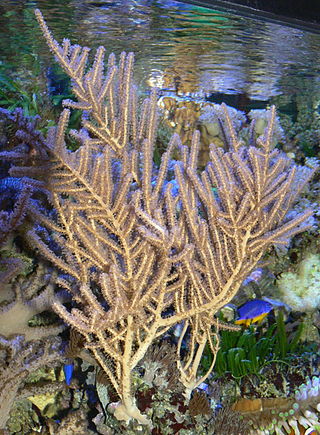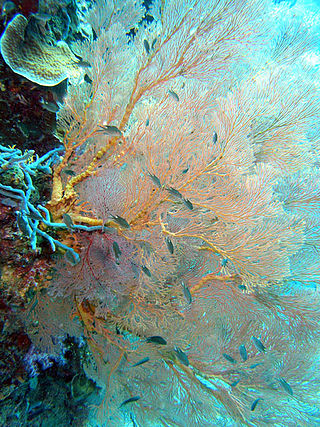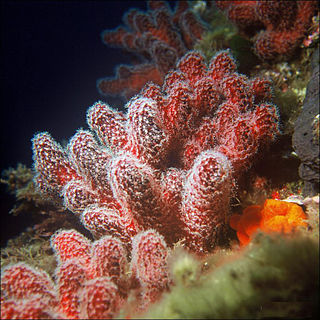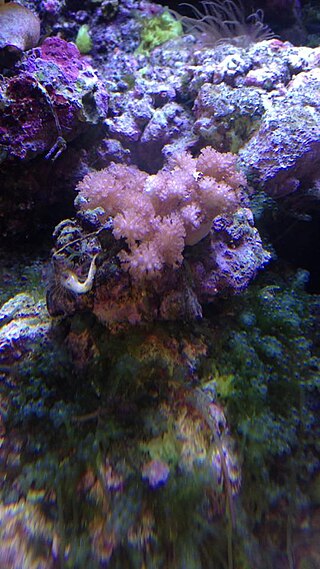
Alcyonacea are a species of sessile colonial cnidarians that are found throughout the oceans of the world, especially in the deep sea, polar waters, tropics and subtropics. Whilst not in a strict taxonomic sense, Alcyonacea are commonly known as "soft corals" (Octocorallia) that are quite different from "true" corals (Scleractinia). The term “soft coral” generally applies to organisms in the two orders Pennatulacea and Alcyonacea with their polyps embedded within a fleshy mass of coenenchymal tissue. Consequently, the term “gorgonian coral” is commonly handed to multiple species in the order Alcyonacea that produce a mineralized skeletal axis composed of calcite and the proteinaceous material gorgonin only and corresponds to only one of several families within the formally accepted taxon Gorgoniidae (Scleractinia). These can be found in order Malacalcyonacea (taxonomic synonyms of include : Alcyoniina, Holaxonia, Protoalcyonaria, Scleraxonia, and Stolonifera. They are sessile colonial cnidarians that are found throughout the oceans of the world, especially in the deep sea, polar waters, tropics and subtropics. Common names for subsets of this order are sea fans and sea whips; others are similar to the sea pens of related order Pennatulacea. Individual tiny polyps form colonies that are normally erect, flattened, branching, and reminiscent of a fan. Others may be whiplike, bushy, or even encrusting. A colony can be several feet high and across, but only a few inches thick. They may be brightly coloured, often purple, red, or yellow. Photosynthetic gorgonians can be successfully kept in captive aquaria.

Xeniidae is a family of soft coral in the order Alcyonacea.

Alcyonium digitatum or dead man's fingers is a species of soft coral in the family Alcyoniidae. It is found around the coasts of the northern Atlantic Ocean and other temperate waters such as the South Pacific.

Holaxonia is a suborder of soft corals, a member of the phylum Cnidaria. Members of this suborder are sometimes known as gorgonians and include the sea blades, the sea fans, the sea rods and the sea whips. These soft corals are colonial, sessile organisms and are generally tree-like in structure. They do not have a hard skeleton composed of calcium carbonate but have a firm but pliable, central axial skeleton composed of a fibrous protein called gorgonin embedded in a tissue matrix, the coenenchyme. In some genera this is permeated with a calcareous substance in the form of fused spicules. Members of this suborder are characterized by having an unspiculated axis and often a soft, chambered central core. The polyps have eight-fold symmetry and in many species, especially in the families Gorgoniidae and Plexauridae, contain symbiotic photosynthetic algae called zooxanthellae. These soft corals are popular in salt water aquaria.

Nephtheidae is a family of soft corals in the phylum Cnidaria. Members of this family are known as carnation corals, tree corals or colt soft corals. They are very attractive and show a wide range of rich and pastel colours including reds, pinks, yellows and purples. They are popular with reef aquarium hobbyists.

Melithaea is a genus of octocorals in the family Melithaeidae. Members of the genus are commonly known as fan corals and are found in the tropical Indo-Pacific region. The type species is Melithaea ochracea.

Alcyonium is a genus of soft corals in the family Alcyoniidae.

Alcyonium palmatum or red dead man's fingers is a species of soft coral in the family Alcyoniidae.

Sinularia is a genus of soft coral in the family Alcyoniidae. They are commonly known as leather corals and currently have 166 described species in the genus.

Sarcophyton glaucum, also known as toadstool leather coral or rough leather coral, is a common species of soft coral found from the Red Sea to western Pacific Ocean. Sarcophyton glaucum belongs to the phylum Cnidaria, the class Anthozoa, and the family Alcyoniidae.

Alcyonium acaule or Mediterranean sea-finger is a species of soft coral in the family Alcyoniidae. It is found at moderate depths on shaded rocks in the Mediterranean Sea and adjoining parts of the Atlantic Ocean.

Alcyonium coralloides, commonly known as false coral, is a colonial species of soft coral in the family Alcyoniidae. It is native to the northeastern Atlantic Ocean and the Mediterranean Sea. In the former location it generally grows as sheets or small lobes but in the latter it is parasitic and overgrows sea fans.

Eunicella singularis, the white gorgonian, is a species of colonial soft coral, a sea fan in the family Gorgoniidae. It is found in the western Mediterranean Sea, Adriatic Sea and Ionian Sea. It was first described in 1791 by the German naturalist Eugenius Johann Christoph Esper.

Cladiella is a genus of soft corals native to the Indo-Pacific region. These corals are commonly known as colt corals or finger leather corals and are often kept in reef aquaria. They grow fast, have short rounded or conical lobes and are sticky to the touch owing to the production of much mucus. They are creamy or pale grey in colour. The polyps are fully retractable and give the colony a fluffy look when extended. They may be a contrasting green or brown hue.

Clavulariidae is a family of soft corals in the suborder Stolonifera. Colonies in this family consist of separate retractable polyps growing from a horizontal, encrusting stolon or basal membrane. The tissues are stiffened by sclerites.

Klyxum is a genus of animals in the family Alcyoniidae. They are commonly called cauliflower colt coral, or simply colt coral. These common names can also refer to the related genus Cladiella.
Rhytisma is a genus of soft corals in the family Alcyoniidae.
Parasphaerasclera is a genus of soft coral. It is the only genus in the monotypic family Parasphaerascleridae.

Sarcophyton is a genus of corals in the family Alcyoniidae that are commonly kept in reef aquaria.















